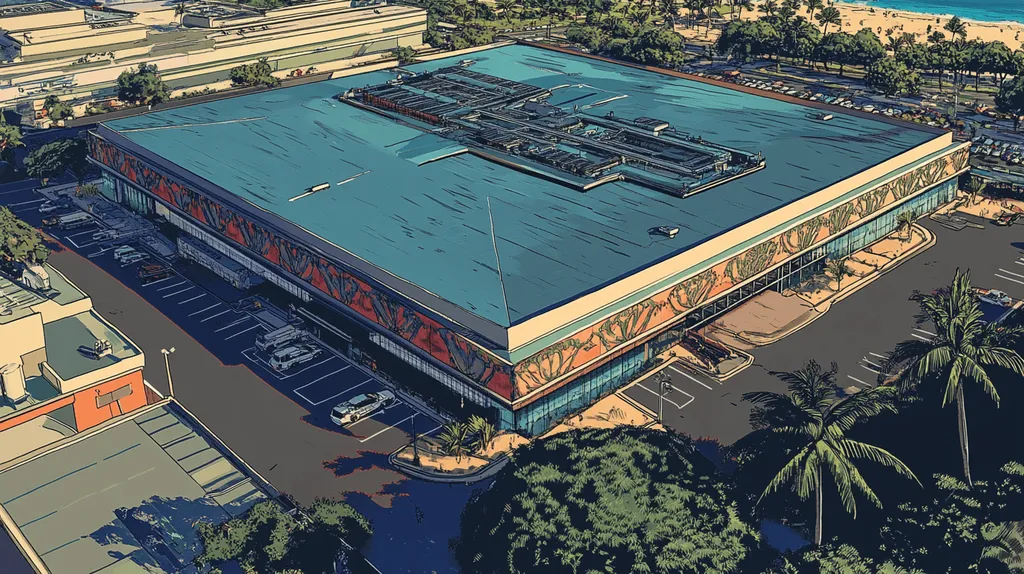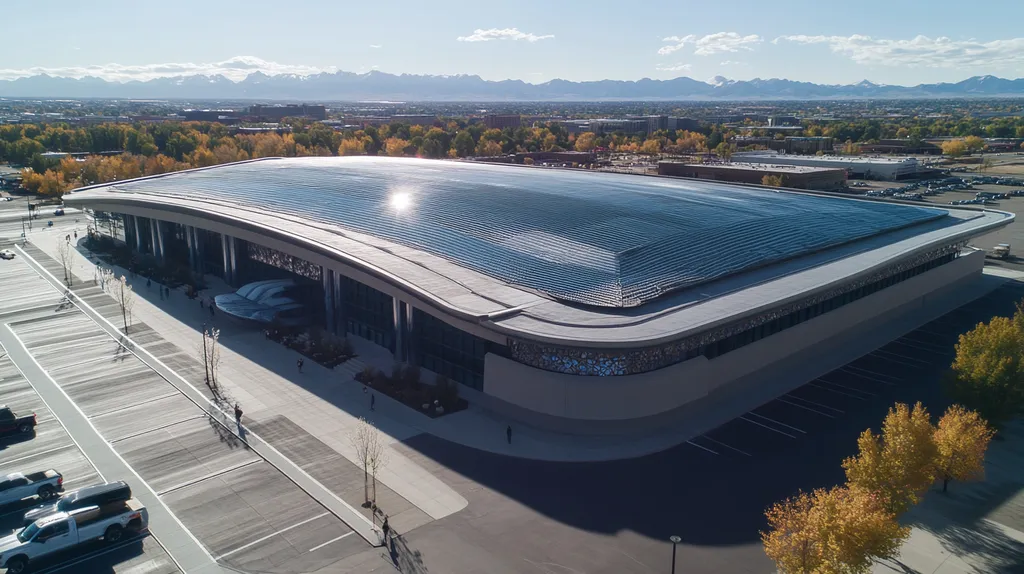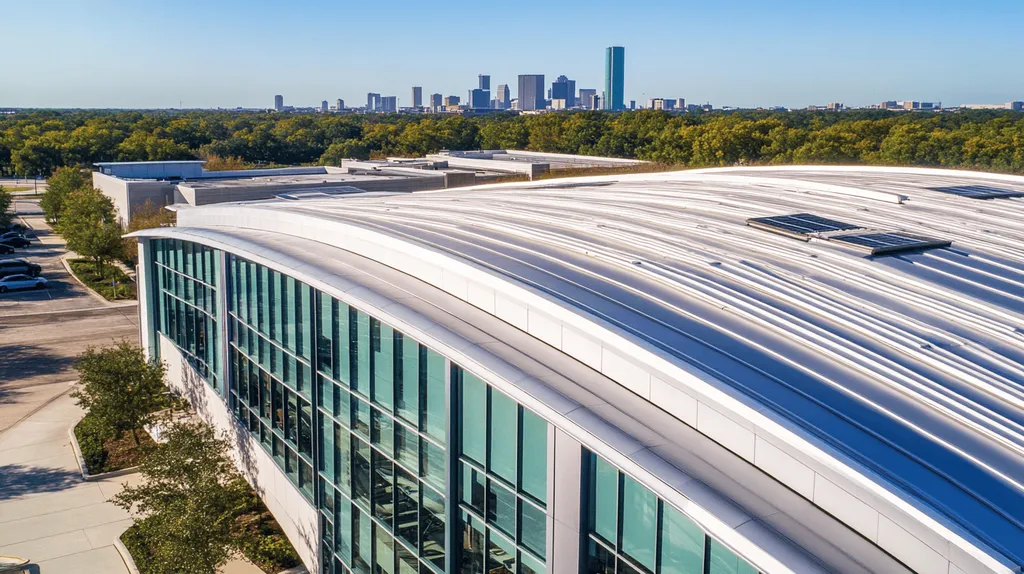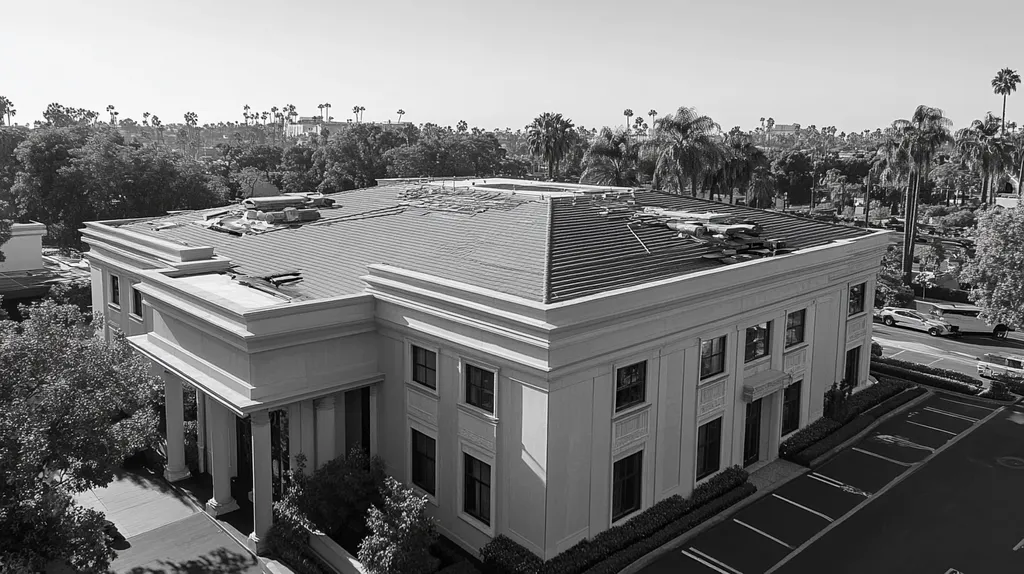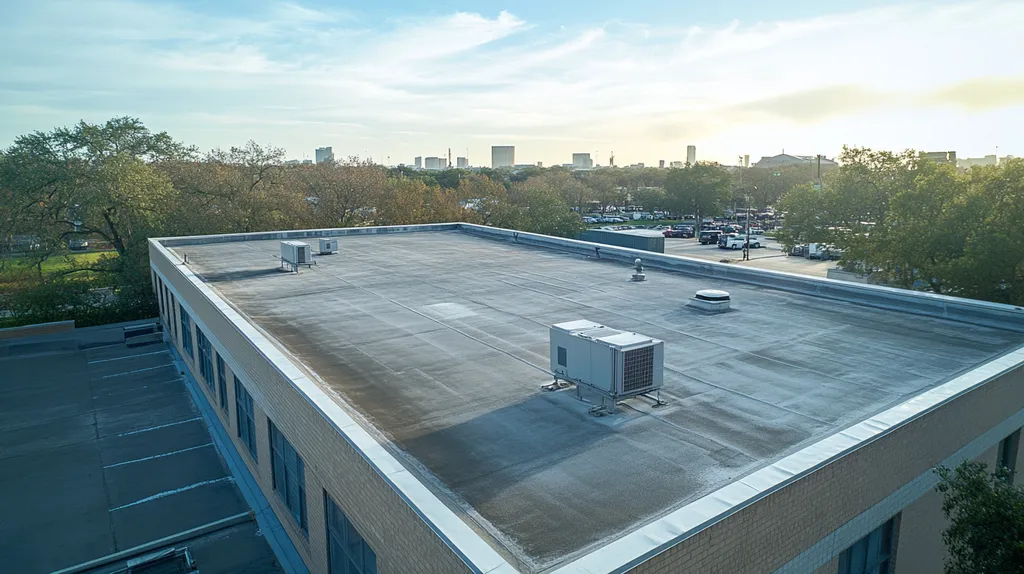Industry studies reveal that 40% of industrial roof failures stem from mismatched coating and drainage systems, resulting in over $2.8 billion in annual repair costs across North America.
As roof coating technology advances and drainage requirements become more complex, facility managers face critical decisions that impact both immediate performance and long-term structural integrity.
This comprehensive guide examines the intricate relationship between industrial roof coatings and drainage systems, providing actionable insights for optimizing system performance and preventing costly failures.
SECTION 1: FUNDAMENTAL CONCEPTS
The interplay between roof coatings and drainage systems forms the cornerstone of effective industrial roofing performance. Industry data shows that over 80% of premature roof failures stem from inadequate drainage and coating issues. With replacement costs averaging $7-15 per square foot, understanding these fundamentals becomes crucial for protecting both the facility and bottom line.
Roof Drainage Basics
Industrial roof drainage operates as an integrated system where every component plays a vital role in water management. Primary drains, secondary overflow systems, and proper slope calculations work together to prevent water accumulation.
A properly designed drainage system should evacuate water within 24 hours of rainfall. Even minor ponding can compress insulation and accelerate coating deterioration, leading to structural concerns.
Strategic drain placement requires careful consideration of roof layout, expected rainfall intensity, and local building codes. Industry standards recommend one drain for every 10,000 square feet of roof area.
Regular inspection of drainage pathways ensures continued effectiveness. Blocked drains can cause catastrophic failures, especially during heavy rainfall events.
Coating Types and Roles
Elastomeric roofing systems provide seamless waterproofing when liquid-applied, while sheet systems rely on properly sealed seams. These coatings must maintain flexibility to accommodate thermal movement and substrate changes. (source: NIST)
Silicone coatings excel in UV resistance and maintain flexibility in extreme temperatures. Their water-resistant properties make them ideal for areas with frequent rainfall.
Acrylic coatings provide cost-effective protection but require careful application timing. Their water-based nature demands complete drying before exposure to precipitation.
Polyurethane systems offer superior impact resistance and durability. Their multiple-layer application creates robust protection against standing water and mechanical damage.
Water Flow Dynamics
Water movement across industrial roofs follows predictable patterns based on slope, surface texture, and coating characteristics. Understanding these patterns prevents drainage system overload.
Surface tension affects how water travels across coated surfaces. Smoother coatings accelerate water flow, while textured surfaces can slow movement and increase retention time.
Wind-driven rain creates unique challenges for drainage systems. Proper edge detail design and coating selection help manage these irregular flow patterns.
Temperature fluctuations impact water behavior on coated surfaces. Expansion and contraction cycles can alter drainage paths, requiring flexible coating systems that maintain integrity.
SECTION 2: SYSTEM COMPONENTS
Industrial roofing systems face unprecedented challenges, with water damage claims exceeding $2.5 billion annually. Effective drainage depends on the seamless integration of components, coatings, and features. Understanding these elements is crucial, as even minor component failures can cascade into major structural issues. This section examines the critical relationship between drainage systems, coating materials, and compatible features that ensure long-term roof performance.
Drainage System Types
Modern industrial roofs employ three primary drainage categories: internal systems, perimeter solutions, and hybrid configurations. Internal systems utilize strategically placed drains and leaders to channel water through the building envelope, offering superior protection against freeze-thaw cycles.
Perimeter solutions incorporate gutters, scuppers, and downspouts to direct water off roof edges. These systems excel in regions with high rainfall intensity but require careful maintenance to prevent debris accumulation.
Hybrid configurations combine internal and perimeter drainage, providing redundancy for critical facilities. This approach ensures continuous water management even if one system becomes compromised.
Each drainage type requires specific installation parameters and maintenance protocols. Climate conditions, roof geometry, and building use significantly influence system selection and performance metrics.
Coating Materials Overview
Elastomeric roofing systems come in liquid-applied or sheet formats, with seam integrity and material compatibility directly impacting waterproofing effectiveness. The membrane’s ability to maintain watertight conditions depends heavily on proper sealing methods and substrate preparation. (source: NIST)
Modified bitumen coatings provide excellent durability but require skilled application to ensure proper adhesion. These systems create a robust barrier against water infiltration when correctly installed.
Reflective coatings reduce thermal stress while enhancing drainage performance. Their smooth surface promotes efficient water flow, preventing ponding and reducing strain on drainage components.
Single-ply membranes offer rapid installation and consistent performance characteristics. However, their effectiveness relies on proper seam sealing and attachment methods.
Compatible Drainage Features
Successful drainage systems incorporate multiple complementary features working in concert. Tapered insulation creates positive slope, while crickets and saddles direct water flow toward collection points.
Drain covers with debris guards prevent clogging while maintaining optimal flow rates. These components require regular inspection to ensure continued effectiveness.
Enhanced perimeter details, including raised edges and waterproof terminations, prevent water infiltration at system boundaries. These features form critical transitions between horizontal and vertical surfaces.
Secondary drainage provisions, including overflow scuppers and emergency drains, provide essential backup protection. Their activation indicates primary system issues requiring immediate attention.
SECTION 3: IMPLEMENTATION METHODS
Proper implementation of industrial roof coatings can mean the difference between a drainage system that performs flawlessly for decades and one that fails within years. Industry data shows that 65% of premature coating failures stem from poor implementation practices, leading to drainage complications and structural damage. With replacement costs averaging $12 per square foot, mastering these methods becomes essential for protecting both the facility and its operating budget.
Surface Preparation Techniques
Surface preparation directly impacts coating adhesion and drainage performance. Professional assessment must identify structural deficiencies, moisture content, and surface contamination before work begins.
Power washing removes debris and oxidation, but timing is crucial. Surfaces require 24-48 hours of drying time to prevent moisture entrapment beneath new coatings.
Proper repairs to existing damage prevent coating failures. Even minor cracks or separations can compromise drainage pathways if not addressed during preparation.
Chemical cleaners and etching agents create optimal bonding surfaces. These treatments must be thoroughly neutralized and rinsed to prevent coating degradation.
Coating Application Guidelines
Environmental conditions significantly impact coating success. Temperature, humidity, and dew point measurements must fall within manufacturer specifications during application and curing phases.
Reflective coatings enhance solar reflectance while improving drainage performance through superior weather resistance. These specialized coatings provide more durability than standard paints and maintain effectiveness across multiple color options. (source: Cool Roof Toolkit)
Application thickness requires precise monitoring. Too thin reduces protection, while excessive thickness can create drainage impediments and surface irregularities.
Curing times vary based on coating type and conditions. Rush jobs that skip proper curing often lead to premature failures and drainage complications.
Integration with Drain Systems
Successful coating integration requires detailed mapping of drainage pathways. Every drain location, valley, and cricket must be identified and properly prepared for coating application.
Coating terminations around drains demand special attention. Proper flashing and sealant compatibility prevent water infiltration at these critical junctions.
Regular drainage testing during application ensures proper flow patterns. Water testing helps identify potential problems before coating fully cures.
Post-installation inspections must verify coating uniformity around drainage components. These checkpoints become reference points for future maintenance assessments.
SECTION 4: MAINTENANCE REQUIREMENTS
Recent industry data reveals that 78% of premature roof failures stem from inadequate maintenance of drainage systems and coatings. With replacement costs averaging $15-20 per square foot, establishing a rigorous maintenance program becomes crucial for protecting industrial facilities. Studies show that properly maintained drainage systems can extend roof life by 40% while reducing annual repair costs by up to 60%.
Inspecting Drainage Systems
Comprehensive drainage inspections must occur quarterly, with additional checks after severe weather events. These evaluations should document water flow patterns, ponding areas, and coating condition around drain assemblies.
Thermal imaging and moisture mapping help identify subsurface issues before they manifest as visible problems. Early detection of moisture infiltration can prevent extensive coating damage and preserve drainage functionality.
Field testing of drain flow rates provides critical performance data. Standard protocols require drains to evacuate 1 inch of standing water within 24 hours under normal conditions.
Documentation through detailed photography and measurement logs creates valuable benchmark data. These records enable tracking of system deterioration and help forecast maintenance needs.
Coating Maintenance Strategies
Elastomeric roofing systems require systematic maintenance to preserve their waterproofing capabilities. Liquid-applied systems need particular attention at seams and termination points, while sheet systems demand regular inspection of mechanical fasteners and adhesive bonds. (source: NIST)
UV degradation indicators, such as surface chalking or discoloration, signal the need for protective treatments. Addressing these signs early prevents coating failure and maintains proper water flow.
Recoating schedules should align with manufacturer specifications and local climate conditions. High-traffic areas and zones near drainage components often require more frequent attention.
Testing coating adhesion and thickness annually helps identify areas requiring rehabilitation. These inspections should focus on drainage paths where water exposure is highest.
Regular Drain Cleaning Practices
Professional drain cleaning must occur at least quarterly, with additional service during heavy foliage seasons. Proper cleaning includes removal of debris from drain bowls, strainers, and leader pipes.
High-pressure water jetting maintains clear drainage paths while testing system integrity. This process identifies potential blockages and confirms proper flow through the entire drainage network.
Installation of drain guards and strainers reduces debris accumulation between cleanings. These devices require monthly inspection to prevent restricted water flow.
Emergency response protocols should include rapid drain clearing procedures. Having these systems in place prevents catastrophic failures during severe weather events.
SECTION 5: PERFORMANCE METRICS
Performance metrics form the backbone of effective industrial roofing management, with coating and drainage issues accounting for over $3.2 billion in annual repair costs nationwide. Recent studies indicate that 40% of industrial facilities lack adequate performance monitoring systems, leading to premature coating failures and compromised drainage. Understanding and tracking these metrics isn’t just about maintenance – it’s about protecting massive capital investments and ensuring operational continuity.
Drainage Efficiency Evaluation
Comprehensive drainage evaluation requires both quantitative measurement and qualitative assessment. Industry standards mandate that properly functioning drainage systems should evacuate 95% of surface water within 12 hours of rainfall cessation.
Digital mapping technology now enables precise identification of low spots and ponding areas. This data helps facility managers optimize drainage patterns and predict potential failure points.
Surface tension testing reveals how different coating types affect water movement. Understanding these interactions helps prevent water accumulation that can degrade coating performance.
Regular evaluation of drain capacity ensures systems can handle peak loads. Even minor reductions in drainage efficiency can cascade into major structural issues during severe weather events.
Coating Durability Assessments
Acrylic coatings require particular attention during durability assessments, as their water-based composition makes them vulnerable to degradation from extended ponding. Alternative materials like silicone often provide superior resistance to standing water in problematic areas. (source: American WeatherStar)
Adhesion testing using standardized pull-off methods identifies weak points before failure occurs. These tests should be conducted quarterly, with additional checks following extreme weather events.
Thickness measurements track coating wear patterns across the roof surface. Special attention must focus on high-traffic areas and zones around drainage components.
Chemical resistance evaluations ensure coatings maintain integrity when exposed to industrial emissions or environmental pollutants. Regular pH testing of roof surfaces guides maintenance scheduling.
Water Flow Rate Monitoring
Flow rate monitoring equipment provides real-time data on drainage system performance. Modern sensors can detect flow reductions as small as 5%, enabling early intervention before problems escalate.
Benchmark testing establishes baseline flow rates for different rainfall intensities. These standards become critical reference points for evaluating system degradation over time.
Weather tracking systems help correlate rainfall data with drainage performance. This information validates system capacity and identifies potential overload conditions.
Regular flow testing of individual drains prevents localized failures. Quarterly assessments should verify that each drain maintains minimum flow rates under various conditions.
SECTION 6: OPTIMIZATION STRATEGIES
Industrial roof optimization has become increasingly critical, with recent data showing that poor drainage and coating choices cost facility owners over $4.2 billion annually in preventable repairs. Studies indicate that 73% of industrial roofs operate at suboptimal efficiency due to mismatched coatings and inadequate drainage solutions. Strategic optimization can extend roof life by 15-20 years while reducing annual maintenance costs by up to 65%.
Enhancing Drainage Efficiency
Modern drainage enhancement requires a systematic approach combining slope analysis, flow modeling, and strategic drain placement. Advanced mapping technology now enables precise identification of water accumulation points before they become problematic.
Strategic placement of auxiliary drains at quarter points significantly improves water evacuation rates. This approach has shown to reduce ponding by 85% compared to traditional corner-only drain configurations.
Tapered insulation systems create positive slope while maintaining energy efficiency. Custom cricket designs redirect water flow patterns to prevent dead valleys and ensure complete drainage.
Integration of smart monitoring systems enables real-time tracking of drainage performance. These systems can detect flow restrictions before visible ponding occurs, enabling proactive maintenance.
Optimizing Coating Selection
Roof coatings play a vital role in preventing ponding water damage when properly matched with existing drainage systems. Selection must prioritize compatibility with slope configurations and local weather patterns to maximize effectiveness. (source: SmartSeal)
High-build elastomeric systems provide superior bridging capabilities across uneven surfaces. Their ability to maintain consistent thickness improves water flow characteristics while protecting underlying substrates.
Reflective coating technologies reduce thermal stress while enhancing drainage performance. Surface temperature reductions of 50-60°F improve coating longevity and maintain proper viscosity for water flow.
Multi-layer application strategies create redundant protection at critical drainage points. This approach ensures consistent performance even as surface layers weather naturally.
Improving System Longevity
System longevity depends on creating synergy between coating properties and drainage design. Regular assessment of coating thickness at drainage pathways prevents premature wear and maintains proper flow characteristics.
Implementation of preventive maintenance protocols extends system life expectancy. Scheduled inspections and targeted repairs prevent minor issues from escalating into major failures.
Strategic recoating schedules based on traffic patterns and drainage zones optimize protection. High-stress areas near drains often require more frequent attention to maintain performance.
Integration of UV-resistant top coats extends system durability in exposed areas. These specialized formulations prevent premature degradation while maintaining proper surface characteristics for water flow.
Looking Ahead
With industrial roof failures costing facilities over $2.8 billion annually, the relationship between coatings and drainage systems demands immediate attention from property managers and building owners.
Studies show that optimized coating and drainage solutions can extend roof life by up to 20 years while reducing maintenance costs by 65%.
The integration of smart monitoring systems, advanced coating technologies, and strategic drainage design represents the future of industrial roofing performance.
Success requires a systematic approach combining proper material selection, professional installation, and rigorous maintenance protocols.
Facilities that implement these comprehensive strategies now will avoid costly failures while maximizing their roofing investment for decades to come.
FREQUENTLY ASKED QUESTIONS
Q. How do coatings on commercial roofs affect drainage systems?
A. The right coatings enhance drainage by directing water flow and preventing ponding. However, mismatched coatings can lead to blockages, compromising drainage efficiency. Understanding how these coatings interact with drainage systems is essential for long-term roof performance.
Q. What are common drainage system types for industrial roofs?
A. Common types include internal drainage, perimeter solutions, and hybrid systems. Each serves unique roles depending on the roof structure and environmental conditions. Selection of the right system directly influences drainage effectiveness and long-term durability.
Q. Why is surface preparation crucial for industrial roof coatings?
A. Proper surface preparation ensures excellent adhesion and performance of the coatings. Any contamination or structural issue can lead to premature failures and drainage issues. Comprehensive cleaning and repairs prevent long-term complications and conserve costs.
Q. How often should maintenance be conducted on industrial roofs?
A. Maintenance should occur at least quarterly, with inspections after severe weather. Regular checks enable early detection of potential issues, ensuring effective drainage and coating longevity. Proactive measures help minimize extensive damage and reduce overall repair costs.
Q. How can performance metrics improve roof management for industrial facilities?
A. Performance metrics enable tracking of drainage efficiency and coating durability. By monitoring these factors, facility managers can address issues before they escalate, reduce repair costs, and extend the overall life of the roof system. Regular assessments are key to effective management.
Q. What optimization strategies can improve drainage on industrial roofs?
A. Strategies include improving slope, strategic drain placement, and integrating smart monitoring systems. These enhancements facilitate better water flow and reduce risks of ponding. Optimizing these factors can significantly lengthen the life of the roof and minimize maintenance costs.
Q. How does temperature affect industrial roof coatings and drainage?
A. Temperature fluctuations can cause coatings to expand or contract, affecting drainage pathways. This movement can lead to cracks or damage over time, which may impede water flow. Choosing flexible coatings may help maintain drainage integrity despite temperature changes.

